Prof McGuire’s
Orthopaedic Services
Clavicle Fractures
The clavicle or "collar bone" is one of the bones that link the shoulder to the rest of the skeleton through the breastplate, also called the sternum. The clavicle is connected to the sternum at a joint called the sternoclavicular joint and is connected to the shoulder at the acromioclavicular joint. Clavicle fractures are fairly common. They usually occur as a result of a fall, often off a bicycle or motorbike, or on an outstretched arm which then transfers force to the clavicle.
When a bone breaks, it causes inflammation due to bleeding of the blood vessels in and around the bone. The broken bone also causes pain due to the damage of the microscopic nerve endings around it. A deformity may also occur due to the two ends displacing, creating an angle between the broken ends. When a collarbone fracture occurs, there is usually pain and swelling around the collarbone. There may also be a visible deformity. The pain normally becomes acute when moving the arm. A collarbone fracture is a common injury that mostly occurs in children and young adults.
Diagnosing clavicle fractures includes a physical exam to examine the affected area for tenderness, inflammation, deformity and an open wound. The orthopaedic surgeon will use an x-ray to determine the extent of the clavicle fracture, pinpoint the location and determine whether there is an injury to the joints.
If the fracture is not displaced or minimally displaced, then it can be treated non-operatively in a sling. With more high energy injuries, the fracture can displace. When this occurs the two ends of the bone lose their connection to each other and overlap. If this happens then, surgery is recommended to restore the length and alignment of the clavicle. Surgery usually involves fixing the fracture with a plate and screws.

